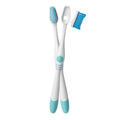The toothbrush, a seemingly mundane item in our daily lives, has a rich history that reflects humanity's ongoing quest for better health and hygiene. While ancient civilizations used rudimentary tools for oral care, it was the Chinese who revolutionized toothbrush design in the 15th century with their use of animal hair bristles attached to bamboo or bone handles.
European aristocrats adopted the toothbrush in the 17th century, but it wasn't until the Industrial Revolution that toothbrushes became more widely accessible. Mass production techniques enabled toothbrushes to reach the masses, marking a significant milestone in oral hygiene practices worldwide.
The introduction of nylon bristles in the 1930s revolutionized toothbrush design once again, providing a more durable and hygienic alternative to animal hair. This innovation paved the way for modern toothbrushes and set the stage for further advancements in oral care technology.
In recent years, there has been a growing emphasis on sustainability in oral care. Biodegradable toothbrushes made from bamboo or recycled materials have gained popularity as eco-friendly alternatives to traditional plastic toothbrushes. Additionally, innovations such as toothbrushes with replaceable heads help reduce waste and promote environmental sustainability.
As we look to the future, the evolution of the toothbrush shows no signs of slowing down. With advancements in materials science, robotics, and artificial intelligence, the possibilities for improving oral care are endless. Smart toothbrushes that monitor brushing habits, detect dental issues early, and provide personalized feedback are already on the market, heralding a new era of preventive dentistry.
In conclusion, the journey of the toothbrush from its humble beginnings to its modern-day iterations is a testament to human ingenuity and our commitment to better health. By understanding the history of the toothbrush, we gain a deeper appreciation for its importance in maintaining oral hygiene and preserving our smiles for generations to come.



